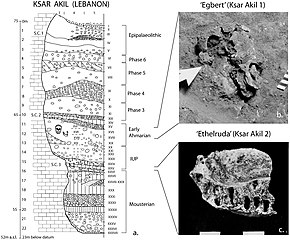

The Levantine corridor is the relatively narrow strip in Western Asia, between the Mediterranean Sea to the northwest and deserts to the southeast, which connects Africa to Eurasia. This corridor is a land route of migrations of animals between Eurasia and Africa. In particular, it is believed that early hominins spread from Africa to Eurasia via the Levantine corridor and Horn of Africa. The corridor is named after the Levant.
Location and geography
The Levantine Corridor is the western part of the Fertile Crescent, the eastern part being Mesopotamia.
Dispersal route for plants
Botanists recognize this area as a dispersal route of plant species.
Dispersal route for humans
The distribution of Y-chromosome and mtDNA haplogroups suggests that during the Paleolithic and Mesolithic periods, the Levantine corridor was more important for bi-directional human migrations between Africa and Eurasia than was the Horn of Africa.
The term is used frequently by archaeologists as an area that includes Cyprus, where important developments occurred during the Neolithic Revolution.
The first sedentary villages were established around fresh water springs and lakes in the Levantine corridor by the Natufian culture.
References
- ^ Higham, Thomas F. G.; Wesselingh, Frank P.; Hedges, Robert E. M.; Bergman, Christopher A.; Douka, Katerina (2013-09-11). "Chronology of Ksar Akil (Lebanon) and Implications for the Colonization of Europe by Anatomically Modern Humans". PLOS ONE. 8 (9): e72931. Bibcode:2013PLoSO...872931D. doi:10.1371/journal.pone.0072931. ISSN 1932-6203. PMC 3770606. PMID 24039825.
- N. Goren-Inbar, John D. Speth (eds.), "Human Paleoecology in the Levantine Corridor". 1994, ISBN 1-84217-155-0 (book review Archived 2011-07-16 at the Wayback Machine)
- Bar-Yosef O. Pleistocene connections between Africa and Southwest Asia: an archaeological perspective, African Archaeological Review, 1987, vol. 5, pp. 29–38.
- J. R. Luis et al., "The Levant versus the Horn of Africa: Evidence for Bidirectional Corridors of Human Migrations" Archived 2012-02-16 at the Wayback Machine, American Journal of Human Genetics, 74: 532-544.
- Alan H. Simmons (15 April 2011). The Neolithic Revolution in the Near East: Transforming the Human Landscape. University of Arizona Press. pp. 33–. ISBN 978-0-8165-2966-7. Retrieved 27 September 2012.
- Graeme Barker (5 December 2000). Archaeology of Drylands: Living on the Margins. Taylor & Francis. pp. 68–. ISBN 978-0-415-23001-8. Retrieved 27 September 2012.
| Syria articles | |||||||||||||
|---|---|---|---|---|---|---|---|---|---|---|---|---|---|
| History |
| ||||||||||||
| Geography |
| ||||||||||||
| Politics |
| ||||||||||||
| Economy |
| ||||||||||||
| Society |
| ||||||||||||